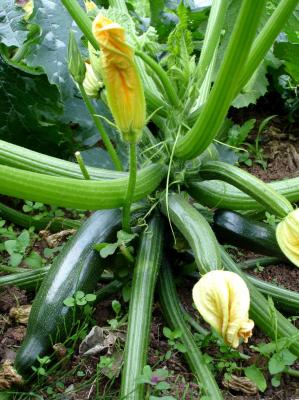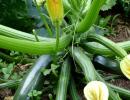
|
Zucchini/Courgette
Scientific name:
Cucurbita pepo
Order/Family:
Violales: Cucurbitaceae
Common names:
Ornamental gourd, Marrow, gourd, Summer squash
Pests and Diseases:
Anthracnose
Aphids
Downy mildew
Epilachna beetles
Fruit flies
Powdery mildew
Viruses
Scab
|
Anthracnose (Colletotrichum orbiculare)
It is the most destructive disease. It causes defoliation and lesions on the fruits.
The fungus can attack all the above-ground plant parts. Cotyledons (seed leaves) of affected seedlings droop and wilt. Lesions (elongated spots) may form on stems of affected seedlings near the ground. Spots on leaves start as small yellowish areas that enlarge and turn brown. The affected tissue dries, breaks and the whole leaf dies. On vines, the spots are elongated and may kill the vines.
Symptoms are most noticeable on fruits. Spots on fruits are circular, black, and sunken. When wet, the centres of the spots become salmon coloured due to a mass of fungal spores. Affected fruits can be destroyed by secondary soft-rot organisms, which enter through broken rind. The fungus is seed-borne. It can survive in crop debris and in weeds belonging to the cucurbit family. Fungal development is promoted by wet conditions, high relative humidity and moderate temperatures (20 to 23.9º C). Its host range includes cucumber, gherkin, gourd, muskmelon, and watermelon. Cucurbit weeds can also be attacked.
- Use resistant varieties, if available.
- Use certified disease-free seeds.
- Practise crop rotation.
- Destroy volunteer cucurbits and weeds.
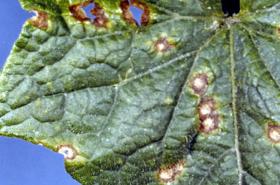
© Clemson University - USDA Cooperative Extension Slide Series, www.insectimages.org
Aphids (Aphis gossypii)
The cotton aphid (Aphis gossypii) is common on cucurbits, including cucumber. Colonies of green to blackish aphids are found on tender shoots, mainly on the lower leaf surface, where they suck sap. The growth of the attacked shoots is stunted and the leaves are curled and twisted. Aphids excrete honeydew, which leads to growth of sooty mould, and may attract fruit flies. Aphids, in particularly winged aphids, transmit virus diseases (e.g. cucumber mosaic virus) when moving from plant to plant.
- Plant barrier crops.
- Apply sticky traps.
- If necessary spray with botanicals (e.g. neem extracts). Spray only attacked plants (spot spraying).
- Use reflective mulch (e.g a polyethylene sheet covered with a thin layer of aluminium that is spread out on the growing bed at planting time). Covering the ground with a material like aluminium foil repels winged aphids, delays aphid colonisation and may delay virus infection.
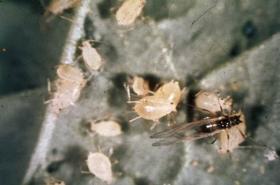
© Mississippi State University Archive, Mississippi State University, Bugwood.org
Downy mildew (Pseudoperonospora cubensis)
Symptoms on leaves appear as small, pale-yellow areas on upper leaf surface. Under humid conditions, a purplish, grey whitish growth may be seen on the underside of the yellowish spots. Affected leaves curl, shrivel and die.
Most downy mildew fungi require cool weather for reproduction and development. This is not true of the cucurbit downy mildew fungus. Optimum temperature for infection is at 16 to 22º C. It can survive when temperatures are over 37.8º C. The most critical factor for infection is a film of moisture and / or long dew periods on leaves. Disease spread is primarily by wind and rain splash. The fungus attacks only members of the cucumber family, mostly those that are cultivated, although it can infect wild cucumber and a few other weed hosts.
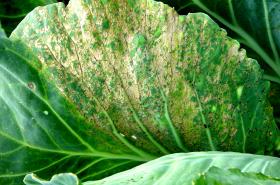
© A.M. Varela, icipe
The Epilachna beetle (Epilachna chrysomelina)
Adults of the Epilachna beetle, also known as the African melon ladybird are 6 to 8 mm long, reddish in colour with a number of black spots on the wing cases. The larvae are 7 to 9 mm in length, soft and covered with dark coloured spines. They pupate on leaves. Both adults and larvae feed on the leaves leaving a fine net of veins. Damaged leaves shrivel and dry up. They may also gnaw stems and eat holes in fruits.
These beetles are most likely to be a problem during establishment when plants are small; young plants can be entirely destroyed. Older plants can tolerate considerable leaf damage, but during flowering fruit set maybe affected. This beetle is a vector of squash mosaic virus. The Epilachna beetle attacks all cucurbits. They often fly into a crop from nearby crops.
- Do not grow pumpkins near crops attractive to the Epilachna beetle (e.g. other cucurbits, potatoes, maize)
- If necessary apply neem products. Simple neem-based pesticides are effective controlling this pest. For instance, weekly foliar sprays of aqueous neem kernel extracts at concentrations of 25, 50 and 100 g/l and neem oil applied with an ultra-low-volume (ULV) sprayer at 10 and 20 l/ha significantly reduced feeding by Epilachna beetles in squash and cucumber in Togo (Ostermann and Dreyer, 1995)
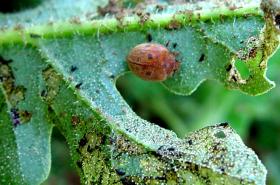
© A. M. Varela, icipe
Fruit flies (Bactrocera cucurbitae, Dacus spp., Ceratitis capitata)
Fruit flies are the most serious insect pests on zucchini/squash with the ability to totally wipe out any marketable fruit.
Fruit flies are about 4-7 mm long, they pierce the fruits and lay eggs in fruits. The fruit fly maggots feed inside the fruit causing sunken, discoloured patches, distortions and open cracks. These cracks serve as entry points for fungi and bacteria, causing fruit rot.
- Frequent applications of neem can keep fruit fly attack to a minimum.
For more information on neem click here. - Avoid continuous cultivation of cucurbits at the same place since this may lead to fruit fly outbreaks.
- Destroy all infested fruit.
- In small plots, wrap individual fruits or bag them with newspaper or paper bags to prevent fruit flies from laying eggs into the fruits. Wrapping or bagging should be started shortly after fruit set.
- Spray with a pyrethrum solution in the evenings after the bees are mostly back in their hives (after 6 pm). There is a product commercially available called "Flower-DS", made of natural pyrethrum and acceptable in organic certified systems (see Hygrotech Company, contact-addresses below).
- Precautions: Be careful to spray late in the evening, follow the spraying instructions. Wear masks and skin protection.
All insect poisons are also poisonous to humans even if coming from natural sources.
- Frequency of spraying: start shortly after beginning of flowering, and repeat approx every 5 days or according to counts.
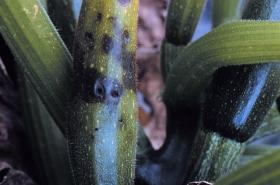
© M. K. Billah, icipe

Fruit fly

Fruit fly

Fruit fly …
Powdery mildew (Sphaerotheca fuliginea and Erysiphe cichoracearum)
Symptoms first develop as a whitish talcum-like powdery growth on upper leaf surface. The powdery growth is composed of fungal spore mass. These areas covered by white powdery growth may enlarge and join up to cover both lower and upper leaf surfaces. Severely affected leaves dry, turn brown and become brittle. Vines can be also attacked. Secondary effects of the disease include sun-burning and premature ripening of fruits.
Powdery mildew affects cucumber, gourd, muskmelon, pumpkin, squash and watermelon. Other hosts include African violets and pawpaws. The powdery mildew fungi are influenced by plant age, humidity and temperature. Foliage is most susceptible 16 to 23 days after unfolding. The fungi reproduce under dry conditions. Infection increases as humidity increases, but does not occur when leaf surface is wet. Optimum temperature for infection is about 27.4º C. However, infection can take place at a temperature as high as 32º C and relative humidity as low as 46%.
- Use resistant varieties, if available.
- Spray with sulphur based fungicides, which provide good control.
- Destroy weeds belonging to the cucurbit family.
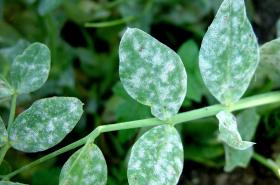
© A.M. Varela

Powdery mi…

Powdery mi…
Virus diseases
The important virus diseases affecting cucurbits. These include:
Cucumber mosaic cucumovirus (CMV)
Watermelon mosaic 2 potyvirus (WMV-2)
Watermelon mosaic 1 potyvirus
Zucchini yellow mosaic potyvirus (ZYMV)
Squash leaf curl bigeminivirus (SLCV).
- For more information on these diseases refer to datasheet on cucumber (click here).
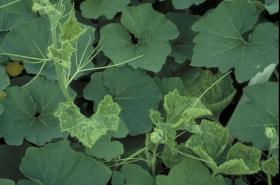
© Courtesy EcoPort (http://www.ecoport.org): S. Pone
| General Information and Agronomic Aspects | Information Source Links | |||
| Information on Pests | Contact Links | |||
| Information on Diseases |
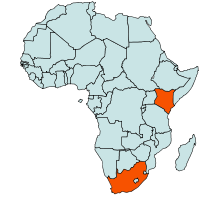 |
| Geographical Distribution of Zucchini in Africa |
Nutritive Value per 100 g of edible Portion
| Raw or Cooked Zucchini | Food Energy (Calories / %Daily Value*) |
Carbohydrates (g / %DV) |
Fat (g / %DV) |
Protein (g / %DV) |
Calcium (g / %DV) |
Phosphorus (mg / %DV) |
Iron (mg / %DV) |
Potassium (mg / %DV) |
Vitamin A (I.U) |
Vitamin C (I.U) |
Vitamin B 6 (I.U) |
Vitamin B 12 (I.U) |
Thiamine (mg / %DV) |
Riboflavin (mg / %DV) |
Ash (g / %DV) |
| Zucchini with skin cooked | 16.0 / 1% | 3.9 / 1% | 0.1 / 0% | 0.6 / 1% | 13.0 / 1% | 40.0 / 4% | 0.4 / 2% | 253 / 7% | 1117 IU / 22% | 4.6 / 8% | 0.1 / 4% | 0.0 / 0% | 0.0 / 3% | 0.0 / 2% | 0.6 |
| Zucchini with skin raw | 16.0 / 1% | 3.3 / 1% | 0.2 / 0% | 1.2 / 2% | 15.0 / 1% | 38.0 / 4% | 0.4 / 2% | 262 / 7% | 200 IU / 4% | 17.0 / 28% | 0.2 / 11% | 0.0 / 0% | 0.0 / 3% | 0.1 / 8% | 0.6 |
Crop yields for summer squash (immature fruits) are 7 to 12 t/ha. Unless grown for seed, mature fruits are not marketable, so plants are removed when yields become too low. Indicative figures for seed yield of zucchini and other squashes are 400 to 1500 kg/ha. In seed production, isolation between fields of different Cucurbita species is recommended, not only for reason of purity but also for obtaining maximum yields (pollen of other species may cause reduced fruit set).
Summer squash of good quality can be kept for up to 14 days when stored at 7 to 10°C and 85 to 95% RH (CAB 2006).
The leaf-feeding Epilachna beetles are a serious problem for Cucurbita growers. Aphids and various leaf beetles can also cause problems on courgetes.
For more information on courgette pests refer to datasheet on cucumber (click here).
|
Fruit flies (Bactrocera cucurbitae, Dacus spp., Ceratitis capitata) Fruit flies are the most serious insect pests on zucchini/squash with the ability to totally wipe out any marketable fruit. | 
Fruit fly
External fruit fly damage symptoms on courgette © M. K. Billah, icipe |
|
What to do:
|
Anthracnose (Colletotrichum orbiculare) is the most destructive disease. It causes defoliation and lesions on the fruits.
Other fungal diseases, mainly affecting the leaves and stems are:
- Powdery mildew (Erysiphe cichoracearum)
- Downy mildew (Peronospora cubensis)
- Scab (Cladosporium cucumerinum)
Many important virus diseases affect cucurbits. These include Cucumber mosaic cucumovirus (CMV), Watermelon mosaic 2 potyvirus (WMV-2), Watermelon mosaic 1 potyvirus, Zucchini yellow mosaic potyvirus (ZYMV), Squash leaf curl bigeminivirus (SLCV).
For more information on these diseases refer to datasheet on cucumber (click here).
|
Virus diseases The important virus diseases affecting cucurbits. These include: |  Zucchini yellow mosaic potyvirus on Cucurbita pepo. ZYMV provokes in cucurbit crops very severe symptoms of stunting, yellowing, necrosis (occasionally), mosaic, leaf deformations, fruit discolourations and deformations. © Courtesy EcoPort (http://www.ecoport.org): S. Pone |
|
What to do:
|
- AIC, Nairobi (2003). Fruits and Vegetables Technical Handbook
- AVRDC International Cooperators' Factsheet on Cucurbits www.avrdc.org
- Beije, C.M., Kanyangia,S.T., Muriuki, S.J.N., Otieno, E.A., Seif, A.A., Whittle, A.M. (1984). Horticultural Crops Protection Handbook. National Horticultural Research Station, Thika. KEN/75/028 and KEN/80/017/
- Blay, E., Cudjoe, A. R., Braun M. (Eds) (2000). Handbook of crop protection recommendations in Ghana: An IPM approach. Vol 2; vegetables. Plant Protection & Regulatory Services Directorate (PPRSD) and the Integrated Crop Protection Project, German Development Cooperation (GTZ).
- Bohlen, E. (1973). Crop pest in Tanzania and their control. Federal Agency for Economic Cooperation (BFE). Veralgh Paul Parey. ISBN 3-489-64826-9.
- CAB (2005). Crop ProtectionCompendium, 2005 Edition. © CAB International Publishing. www.cabi.org
- CAB (2006). Crop ProtectionCompendium, 2006 Edition. © CAB International Publishing. www.cabi.org
- EcoPort. The consilience engine. www.ecoport.org
- Ekesi, S., Billah M. K. (Eds) (2006. A field guide to the management of economically important tephritid fruit flies in Africa. ICIPE. ISBN: 92-9064-179-7.
- Ministry of Agriculture and Rural Development (Kenya) (MoARD) & Japan International Cooperation Agency (JICA) (2000). Local and Export Vegetables Growing Manual. Reprinted by Agricultural Information Resource Centre, Nairobi, Kenya. 274 pp.
- Nutrition Data www.nutritiondata.com.
- Ostermann, H. and Dreyer, M. (1995). Vegetables and grain legumes. In: The Neem tree Azadirachta indica A. Juss. and other meliaceous plants sources of unique natural products for integrated pest management, industry and other purposes? Edited by H. Schmutterer in collaboration with K. R. S. Ascher, M. B. Isman, M. Jacobson, C. M. Ketkar, W. Kraus, H. Rembolt, and R.C. Saxena. VCH. pp. 392-403. ISBN: 3-527-30054-6
- Park SoDeuk, Kwon TaeYong, Lim Yang Sook, Jung KiChae, Choi BooSull (1996). Disease survey in melon, watermelon, and cucumber with different successive cropping periods under vinylhouse conditions. Korean Journal of Plant Pathology, 12(4):428-431.
- Plants for a Future (2003). Edible, medicinal and useful plants for a healthier world. www.pfaf.org
- Sherf, A.F., Macnab, A.A. (1986). Vegetable Diseases and Their Control. 2nd. Edition. John Wiley & Sons Inc. USA. ISBN: 0-471-05860-2
- University of Georgia: College of Agricultural and Environmental Sciences, Department of Horticulture Vegetable Crops: Pumpkin.
- For information on small scale farming techniques, seeds, equipment and insecticides (e.g. pyrethrum solution).
HYGROTECH EAST AFRICA, LTD
Region :KENYA / TANZANIA - Location: NAIROBI
Address :P.O.Box 41446, Nairobi, Tigoni Centre, Limuru Road, KENYA
Phone :+254 (0) 20 205 3916-8
Fax :+254 (0) 20 205 3921
E-Mail: andrew@hygrotech.co.ke

 Back
Back
